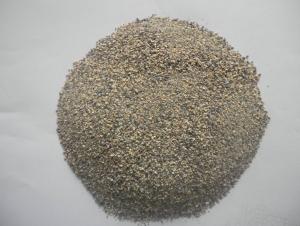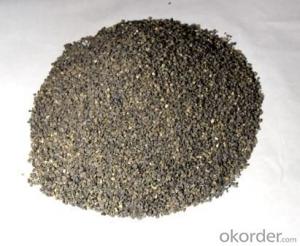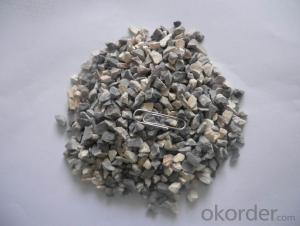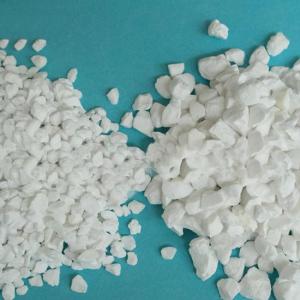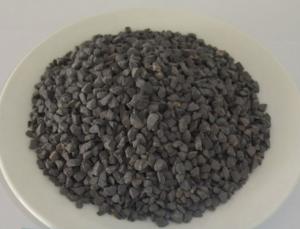Raw Materials for Refractory:Refractory Grade Calcined Bauxite 85% Powder
- Loading Port:
- Tianjin
- Payment Terms:
- TT OR LC
- Min Order Qty:
- 25 m.t.
- Supply Capability:
- 12000 m.t./month
OKorder Service Pledge
OKorder Financial Service
You Might Also Like
Refractory Grade Calcined Bauxite 85% Powder
Calcined Bauxite Introduction
Property | Specifications |
Name | aluminous soil ; bauxite |
Color | White, offwhite, auburnish yellow or light red (with Fe) |
Bulk Density | 2.55~3.6 g/cm3 |
Hardness | 1~3 |
Main usages | 1. Aluminium metallurgy 2.Refractory |
Calcined Bauxite Specifications

Calcined Bauxite Applications
1. Aluminium metallurgy
2. Precision casting / Investment casting:
bauxite grog fines can be made into mold for precision casting.
3. Refractory: high alumina bauxite’s refractoriness can reach 1780°C.
It is charactered by good chemical stability and mechanical performance. (Al2O3 ≥48% with low Fe2O3)
4. Aluminium silicate refractory fiber: The high alumina bauxite grog can melt under 2000°C-2200°C in the electric arc furnace.After a series of processing, it can become aluminium silicate refractory fiber,
which can be made into fiber blanket, plate,cloth.
5. Mixing magnesia and bauxite grog with binders to pour the molten steel ladle for better overall lining
performance.
Usage
(1) aluminium industry. Used in national defense, aerospace, automotive, electronics, chemical industry,
daily necessities, etc.
2 precision casting. Alumina clinker made after the mould precision casting processed into fine powder.
Used in military industry, aerospace, communications, instrumentation, machinery and medical equipment department.
(3) is used for refractory products. High bauxite clinker refractoriness is as high as 1780, chemical stability strong,
and good physical properties.
(4) aluminum silicate refractory fiber. With light weight, high temperature resistance, good thermal stability,
low thermal conductivity, heat capacity is small and the advantages of resistance to mechanical shock.
Used in iron and steel, nonferrous metallurgy, electronics, petroleum, chemical, aerospace, atomic energy,
defense and other industries.
(5) in magnesia and bauxite clinker as raw materials, add the appropriate binder,
used for pouring ladle whole ladle lining has particularly good effects.
(6) manufacture alumina cement, abrasive materials,
ceramic industry and chemical industry can be aluminum of various compounds
Pictures:
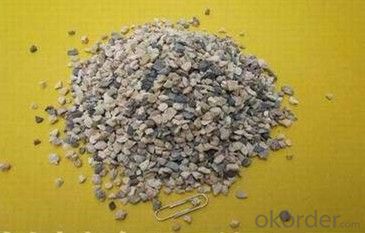


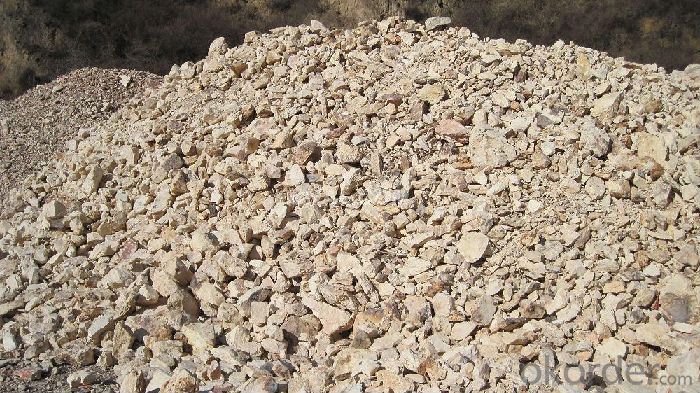
- Q: Can anyone tell me what is A-leve fireproof material?
- What you say is probably palstic! B-level means the fireproof rating is at B1-level because palstic material doesn't belong to fireproof materials. It only is fire?retardant. When wholesaling all kinds of insulation materials and construction, it need tos look at the names. B1-level refers to the fire endurance rating of the fireproof material, which is determined according to the fire resistance of the material. In addition, different parts of the material have different fire endurance ratings! You can download a "Specifications of Fireproof Design for Buildings" for further information!
- Q: Physical and chemical indicators of various refractory.
- please read"Refractories Standard Series" for refernece, general business standards are higher than the national standard.
- Q: Which are fireproofing external wall materials?
- According to combustion performance, external wall thermal insulation materials are classified as Grade-A and Grade-B. Grade-A refers to incombustible material and Grade-B combustible material. A few years ago the fire in CCTV building and Shenyang Hotel were caused by Grade-B material. Currently Grade-A material is more commonly uesd and less expensive than Grade-B material. Grade-A material can be divided into thermal mortar, phenolic foam board, rock wool board, foam cement board, etc. Thermal mortar is easy for construction and unexpensive, but it is also easy for faking due tou its simple procesing. It is recommended to find a large factory whihc has gone through the formalities.
- Q: Can anyone say something about the curtain wall fire-proof material key sealing point?
- Keypoints; 1, curtain wall design must consider the safety requirements, one of which is fire protection design. 2, Generally, fire protection planning between curtain walls should use the method of setting fireproof isolation layer. 3, Two layers of fireproof isolation layer whose thickness should not be less than 100mm respectively on the top edge and lower edge of the material parts of the house. 4, the fireproof isolation layer commonly uses 1.5mm thick galvanized steel sheet as supporting plate, using for shelving fireproof sheet. The 100mm thick cavity between the layers is filled with mineral wool non-combustible materials tightly covered with tinfoil on the surfaces. 5, protective isolation layer should try to reconcile curtain wall beam level and finish floor level, so as to fill non-combustible material and to avoid that a piece of glass acrosses two fire?compartments. 6, the beam should be inside 100mm thick fireproof isolation layer to protect the beam and the upper curtain wall plate. 7, when there are open fire function areas like large-scale hotel or restaurant kitchen inside the curtain walls, curtain wall glass in these parts should consider using cesium potassium fireproof glass to improve the fireproof rating in the region. 8, Fireproof setting in the around areas of curtain wall can use the same method of the above fireproof setting between layers. The joint parts of fireproof isolaton layer and main part as well as curtain wall should use fireproof sealant to seal.
- Q: whether the fire resistant level of aerated concrete building blocks can reach the grade one?
- it has fire resistant level, incombustible?material,and it should reach grade one level.
- Q: What's the maximum temperature that the refractory ceramic fiber cloth can endure?
- While the refractory ceramic fiber cloth is different in high temperature resistance, and in general it can endure the high temperature of more than 1000℃. Ceramics in daily use and art ceramics: Bone china and Guangdong chinaware can generally endure the highest temperature of 1100℃. Jingdezhen porcelain and ceramics: They can generally endure the highest temperature of 1280℃-1340℃, and some special ones can endure the highest temperature of 1400℃. Industrial ceramics: Some of them can endure the highest temperature of about 2600℃. (alumina ceramics: their melting point is 2050℃, and boiling point is 3000℃).
- Q: What kind of refractory materials are used in metallurgy industry?
- Argon-blowing rod, siliceous dry vibrating materials, desulfurizer, slag-stopping ball, stainless steel thermal insulating agent with high efficiency, dry vibration material, sizing nozzle heat-insulating panel, chrome refractory , refractory carstables for ladles, magnesia carbon refractory, package castable, siliceous drainage agent, tundish block, iron trough, deoxidizer, compound deoxidizer,silicon manganese alloy , stemming, floating plug,slagging agent. The main materials are as follows: recarburizer, covering agent, intermediate frequency furnace burden, mould fluxes, insulation thin slag agent, skimmer repair material, joint sealant.
- Q: What defect does fused cast refractories have ?
- What defect doesfusion-cast refractory material have ? In glass production, in addition to refractory as a building material and consider its durability, we still must attach great importance to its influence on glass quality. In such cases, the impact on the quality of glass is mainly the defects that eroded down refractory materials mixed in the glass, thus being prodeced of grass products. Defects are mainly foreign body defects such as sand, knot and wave reinforcement. What may directly affect the quality of glass are sidewall block and brick kiln bottom. I hope my answer can help you.
- Q: Are refractory materials and fireproofing materials the same?
- The refractory material and fireproofing material are not the same in the strict sense. Refractories refer to non-metallic materials of which refractoriness are higher than 1580 degrees. Now commonly used heat insulation materials can also be considered as refractory materials. The fire endurance of fireproof materials reaches certain requirements. Its test temperature is 540 degrees. Range of applications for two material are not the same. Refractory materials can be used in high-temperature region as it can withstand high temperature. Fireproof materials can not be used under high temperatures for a long time.
- Q: What are the requirements for fire?rating of construction suspended ceiling material ?
- In fireproof design of all parts in interior decoration, fireproof design of suspended ceiling is the most important. Because the flame is burning up in fire and the suspended ceiling is the first and most direct part to test fire; at the same time, it has a direct impact on the evacuation. Therefore, in indoor suspended ceiling decoration design, fireproof work should be considered fully. Code of fire prevention design of interior decoratio of buildings has detailed provisions for fireproof?performance of indoor suspended ceiling materiial of different civil buildings. Suspended ceiling (sprung roof) refers to the top decoration of a house. Suspended ceiling, an important sub-project in construction decoration project, and the hidden layer of electrical equipment, ventilation and air condition, communication and fireproof, alarm pipelines, etc. has the functions of thermal insulation, sound insulation and absorption. Suspended ceiling plays an important role on the entire house decoration. Proper decoration to the house top surface, can not only beautify indoor environment, but also create a colorful interior artistic image. When choosing decoration materials and design of suspended ceiling, you should follow the principle of saving material, being solid, safe, beautiful and practical.
Send your message to us
Raw Materials for Refractory:Refractory Grade Calcined Bauxite 85% Powder
- Loading Port:
- Tianjin
- Payment Terms:
- TT OR LC
- Min Order Qty:
- 25 m.t.
- Supply Capability:
- 12000 m.t./month
OKorder Service Pledge
OKorder Financial Service
Similar products
Hot products
Hot Searches
Related keywords











